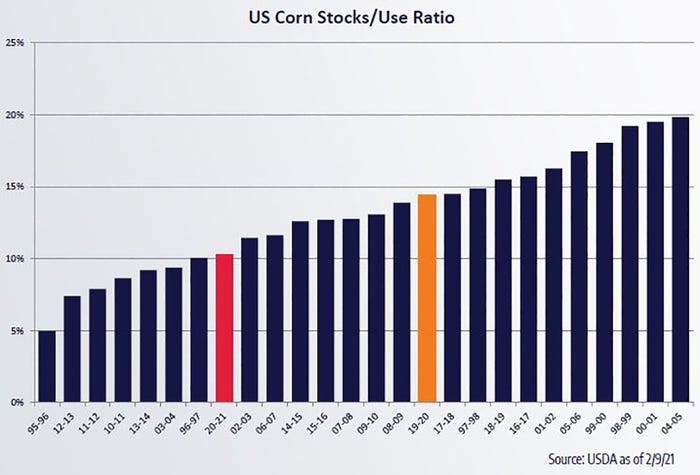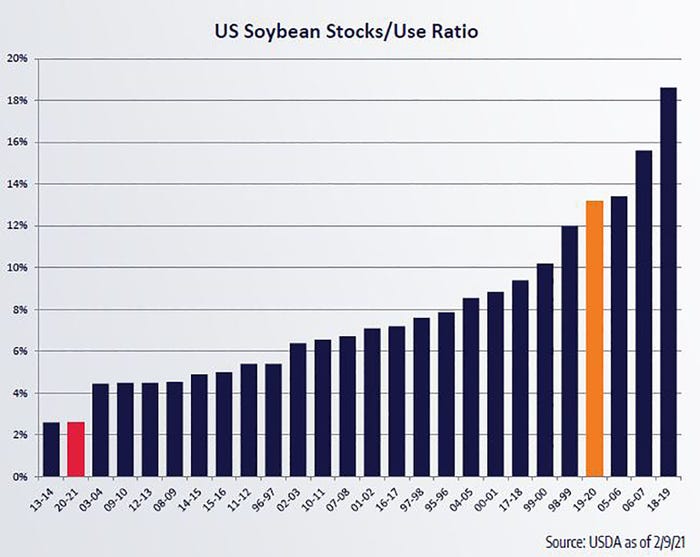
While grain market fundamentals remain supportive in the bigger picture, the recent rally appears to be running out of steam.
Corn futures even signaled a topping sign on daily charts back on February 9th, after the USDA report released that day was viewed as “not bullish enough,” sending prices lower at end of day. Soybean futures are also signaling a pause on the bullish trend, and have been trading in a sideways trading pattern for nearly two months.
While we do not feel corn and soybean futures prices will fall dramatically lower, there is little incentive for prices to rally higher in the short term.
Priced in bullish supply, demand data
Corn futures did not receive much in the way of fresh fundamental news in the February USDA report. Ending stocks were reduced to 1.502 billion bushels, with a stocks-to-use ratio now at 10.3%. While friendly, this news was largely expected and already priced into the market.

The soybean old crop fundamentals remain friendly. The stocks-to-use ratio is now tied for the tightest in history at 2.6%. Export demand is strong with export sales near 95% of USDA projections of 2.25 billion bushels. Export inspections (what has actually left the country already) is pegged at 80% of USDA projections, well ahead of the normal 5-year average pace.

Earlier this week, the NOPA crush report was released. The report was supportive, announcing that 184 million bushels of soybeans were crushed in the month of January. 184 million bushels was the second largest crush number, ever.
So why aren’t prices higher?
Well, there isn’t much out there for new export sales, and there likely won’t be either. Remember, this is a seasonally normal pattern for export sales to dwindle in the months ahead as the South American crop is being harvested, and ready to be shipped around the world. The next USDA report is not until March 9th.
Quite frankly there likely won’t be much fresh bullish news announced between now and then.
Larger acreage expected
The USDA Outlook Forum will likely show expected larger corn and soybean acres to be planted in the United States this spring. This perception will likely keep a lid on any type of new crop corn or soybean rally for a few weeks until the March 31 perspective plantings report announces the official government data. One thing to keep in mind, because the old crop corn and soybean story is so friendly, new crop prices likely won’t fall apart either. A sideways trading range seems likely to develop in the weeks ahead.
Potential bullish signs
A surprise move for this market would be if China made any large export purchases in the next few weeks. Trade is expecting China to shift their attention to South American supplies, so any fresh announced export sales would be a welcomed bullish announcement.
Also, that second crop corn in Brazil is very slow to get planted because the soybean harvest is behind schedule. The longer it takes for that second crop corn to get into the ground, the more it is at risk of key development during the traditional dry season in Brazil. Remember, 70% of the corn that is grown in Brazil is from the second crop corn production.
If you’re thinking of making any additional old or new crop sales, this might be your best opportunity in the short term. While futures prices could have potential to explode higher this summer depending on U.S. weather, don’t lose sight of the opportunity in front of you.
Reach Naomi Blohm: 800-334-9779 Twitter: @naomiblohm and [email protected]
Disclaimer: The data contained herein is believed to be drawn from reliable sources but cannot be guaranteed. Individuals acting on this information are responsible for their own actions. Commodity trading may not be suitable for all recipients of this report. Futures and options trading involve significant risk of loss and may not be suitable for everyone. Therefore, carefully consider whether such trading is suitable for you in light of your financial condition. No representation is being made that scenario planning, strategy or discipline will guarantee success or profits. Any decisions you may make to buy, sell or hold a futures or options position on such research are entirely your own and not in any way deemed to be endorsed by or attributed to Total Farm Marketing. Total Farm Marketing and TFM refer to Stewart-Peterson Group Inc., Stewart-Peterson Inc., and SP Risk Services LLC. Stewart-Peterson Group Inc. is registered with the Commodity Futures Trading Commission (CFTC) as an introducing broker and is a member of National Futures Association. SP Risk Services, LLC is an insurance agency and an equal opportunity provider. Stewart-Peterson Inc. is a publishing company. A customer may have relationships with all three companies. SP Risk Services LLC and Stewart-Peterson Inc. are wholly owned by Stewart-Peterson Group Inc. unless otherwise noted, services referenced are services of Stewart-Peterson Group Inc. Presented for solicitation.
The opinions of the author are not necessarily those of Farm Futures or Farm Progress.
About the Author(s)
You May Also Like






